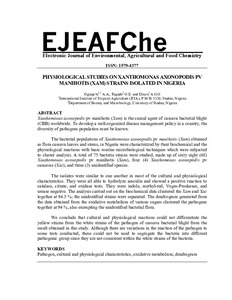| dc.contributor.author | Ogunjobi, A. |
| dc.contributor.author | Fagade, O. |
| dc.contributor.author | Dixon, A. |
| dc.date.accessioned | 2019-12-04T11:18:17Z |
| dc.date.available | 2019-12-04T11:18:17Z |
| dc.date.issued | 2007 |
| dc.identifier.citation | Ogunjobi, A.A., Fagade, O.E. & Dixon, A. (2007). Physiological studies on Xanthomonas axonopodis pv manihotis (Xam) strains isolated in Nigeria. Electronic Journal of Environmental, Agricultural and Food Chemistry, 6(10), 2482-2489. |
| dc.identifier.issn | 1579-4377 |
| dc.identifier.uri | https://hdl.handle.net/20.500.12478/3148 |
| dc.description.abstract | Xanthomonas axonopodis pv manihotis (Xam) is the causal agent of cassava bacterial blight (CBB)worldwide. To develop a well-organized disease management policy in a country, the diversity of pathogenspopulation must be known. The bacterial populations of Xanthomonas axonopodispvmanihotis (Xam)obtained as flora cassava leaves and stems, in Nigeria were characterized by their biochemical and thephysiological reactions with basic routine microbiological techniques which were subjected to cluster analysis.A total of 75 bacteria strains were studied, made up of sixty eight (68) Xanthomonas axonopodis pv manihotis(Xam), four (4)Xanthomonas axonopodispv cassavae (Xac) and three (3) unidentified species. The isolateswere similar to one another in most of the cultural and physiological characteristics. They were all able tohydrolyze aesculin and showed a positive reaction to catalase, citrate and oxidase tests. They were indole,methyl-red, Voges-Proskauer and urease negative. The analysis carried out on the biochemical data clusteredtheXamandXactogether at 94.5 %; the unidentified strains were separated. The dendrogram generated fromthe data obtained from the oxidative metabolism of various sugars clustered the pathogens together at 94 %,also exempting the unidentified bacterial flora. We conclude that cultural and physiological reactions could notdifferentiate the yellow strains from the white strains of the pathogen of cassava bacterial blight from the resultobtained in this study. Although there are variations in the reaction of the pathogen to some tests conducted,these could not be used to segregate the bacteria into different pathogenic group since they are not consistentwithin the white strains of the bacteria. |
| dc.language.iso | en |
| dc.subject | Pathogen |
| dc.subject | Cultural And Physiological Characteristics |
| dc.subject | Oxidative Metabolism |
| dc.subject | Dendrogram |
| dc.title | Physiological studies on Xanthomonas axonopodis pv Manihotis (Xam) strains isolated in Nigeria |
| dc.type | Journal Article |
| dc.description.version | Peer Review |
| cg.contributor.affiliation | University of Ibadan |
| cg.contributor.affiliation | International Institute of Tropical Agriculture |
| cg.coverage.region | Africa |
| cg.coverage.region | West Africa |
| cg.coverage.country | Nigeria |
| cg.authorship.types | CGIAR and developing country institute |
| cg.iitasubject | Pests Of Plants |
| cg.iitasubject | Plant Diseases |
| cg.iitasubject | Disease Control |
| cg.iitasubject | Tissue Culture |
| cg.accessibilitystatus | Limited Access |
| local.dspaceid | 94614 |

